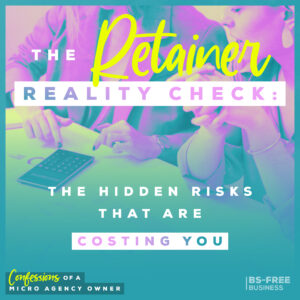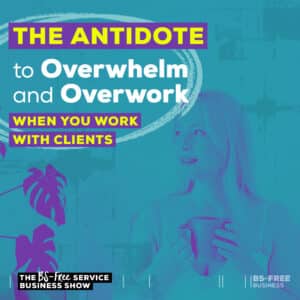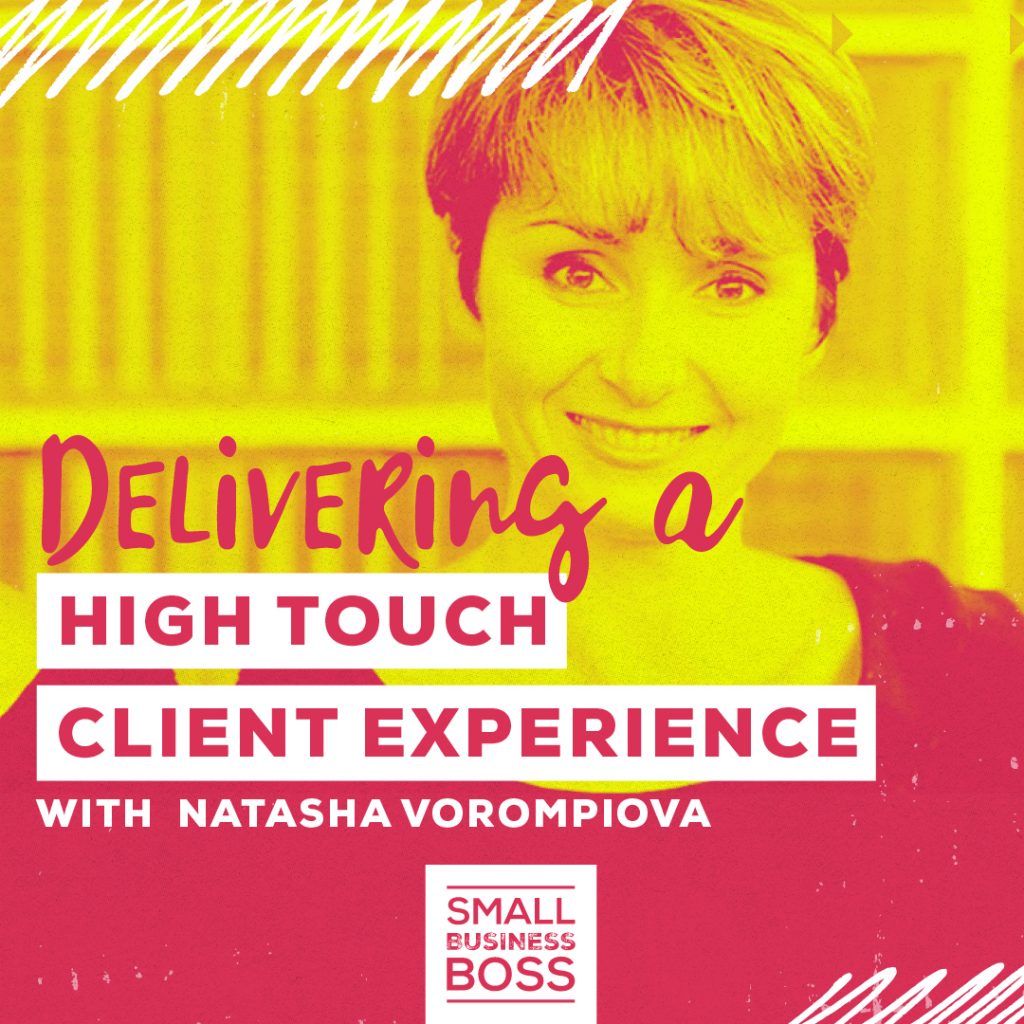
Search the site:
Episode 156: Delivering a High Touch Client Experience with Natasha Vorompiova
As a service business owner, you want to always ensure that you’re providing an amazing client experience. But where’s the line between high touch and what we should automate? Where should we focus on automation and where do we do things manually? In this episode, Natasha from Systems Rock is going to help us figure out the answers to those questions.
Systems are something that people always have a lot of questions about, and I’m going to be honest, I love systems, but this talk sometimes pains me. Why, you ask? Well, I see a lot of people worrying about systems and automations long before they really need to. It can easily be a form of procrastination from doing harder work — like finding clients.
I invited Natasha to join us on the show to help us figure out where we should automate, how we can do that without sacrificing client experience, and where we may be able to save time and sanity.
Natasha’s Bio
Natasha Vorompiova is the founder of SystemsRock and Capacity Architect. She helps her clients break through the capacity ceiling and breathe oxygen back into their business so they feel comfortable and safe to continue to grow.
Natasha’s specialty is streamlining and supercharging her clients’ information systems so that they can finally take full advantage of the data and information they have.
Natasha strongly believes that when our systems are broken, adding more people to work around the inefficiencies can make things even worse. On the other hand, when we make it a priority to simplify, supercharge, and automate our processes, our capacity can be limitless.
So, why don’t you start off by telling us a little bit about your business and how you make money?
- Absolutely. I am a capacity architect and what I do is I help my clients break through the capacity ceiling.
- A lot of times when we grow our business, and we get too busy growing and launching new campaigns and doing all these different marketing efforts, we will look at the challenges that we encounter and create systems around that.
- But we move so quickly a lot of times that we end up having these almost islands of systems on the back end, that don’t really talk to each other and over time become super difficult to manage.
- So, a lot of my clients have this experience of not being able to grow further just because there are so many pieces in the back end that need their attention that they cannot really take on any more clients because they’re afraid that things would just start falling through the cracks.
- What my team and I do is we come in and help them to unravel all those difficult places systems wise and create flow, create more efficiency, so that things start working again, so that different tools talk to each other so that their team members don’t have to do the same tasks over and over again which creates peace of mind that they can actually take more clients. So, a lot of times when we do that they don’t even need to add more team members in order to be able to grow; things just start working so well that this capacity corridor opens up, and they’re able to do more, while not doing so much back end mindless work.
I love that you bring up capacity because it’s something like within the art agency we’re constantly talking about like ‘Do we have the capacity for this? What happens if we add three more clients? It’s always kind of this stress testing. So, if I were to come to you as an agency owner or any type of business owner, how would you serve us? What kind of services do you and your team offer?
- Well, we always start with this analysis where we look at how things work right now.
- We strongly believe in tailoring systems to our clients, we never ever suggest those kinds of turnkey solutions or be like ‘Okay, we come in, we do this, and this is the best system. We never do that, we always go from, ‘Okay, let’s talk about how you work, what already works, and what are those places where you’re experiencing right now a bit of tension, or what are some areas where you are concerned that things would start going through the cracks?’ And we look at that and given that kind of picture we begin suggesting solutions, but usually, it goes through three phases.
- We begin with simplifying things, then supercharging things, and then automating things. So, we look at all these different tools that you use and a way where tools might not be talking to each other or where information needs to be recorded, the same information in many different places. Where are those places where things don’t work as they could work? And from there we will look at possible solutions.
I love that you look at how things are working and what’s not working, so I think one of the biggest things I hear from my clients, they’re always like ‘But I don’t want you to come in and change my product management system and just force this change. It’s a matter of you guys really architecting what is that best option going to be to make this work better for your business versus like, ‘Here’s our only one way we do it.’
- Absolutely, no. That never works, and in my experience, what I always tell my clients in the way we approach things is the ‘best systems come from within,’ so we as business owners know what works for us, we have been doing things for quite a while by the systems expert comes in to know that okay, this is what works, these are my preferences, this is what I’ve tried and what worked, that’s worked, that didn’t work, this is why I made this choice.
- So, we have to take into account all this intelligence and everything, like all these experiences that business owners have gone through before talking to us to be able to create something that will work for this business moving forward, just because we have to create routines that we can easily fall into, versus having these systems that everybody feels that they have to kind of change themselves to work the system. That never works anyway so what’s the point.
One of the things I’ve always known you for is your focus on systems but also doing it in a way that is really focused on that client experience and keeping that high-touch system, so I want to know, as service provider, how can we balance the creation of systems to get rid of kind of manual tasks and manual work but still maintain that high level of service for our clients and really focus on making it so it’s seamless to the client?
- This is such a great question because this is a really fine balance, and it is actually achievable.
- This is something that a lot of my are clients concerned about when I tell them that we could automate things, or we could look at what we could automate because the first impulse is just “No, I’m very high touch, I’m proud of it, I want to be high touch.”
- I don’t want my clients to feel that all this add in the process becomes impersonal — I love offering high touch experiences to my clients as well so I totally understand that — and there are always things on the back end that we can streamline.
- So, another point of view that I want to share is that a lot of times when we need to do something, the question we ask, as business owners, like working with without our teams, for example, the business owner asks, ‘Okay, who is going to do this?” However, what I believe the step that needs to happen before deciding who is going to take care of this, is how we are going to do this.
- There are so many things that could be potentially streamlined that we don’t even envision the possibility of streamlining them because we’ve been doing things for such a long time and we were used to doing things the same way.
- With my clients, we always look at, ‘Okay, what is the type of experience you want to deliver to your clients? How do you want to make your clients feel? What are your cultural values, something that is super, super important to you? What is that impression that you want your clients to have as they work with you?’
- So, once those pieces are clear and we know that these are non-negotiables, this is something that has to be there, we just put those as markers and make sure that those pieces stay as a super personal and if there is a way to kind of streamline a bit — without adding any automations that would make the experience impersonal — we’ll say, ‘Okay, given all of this, what are the remaining pieces?’
- And, first, is there a way to streamline the process a bit further? Like, do we attempt to enter information about this client in several places? Maybe it goes into this CRM and it goes in google drive because the client filled out the form.
- Maybe it’s also in the invoicing tool, and there like we need to again enter the name and the address and everything, and look at as okay, if those are the pieces that need to happen and they either actually don’t affect the client, is there something that we can do about that?
- Is there a way for us to have these different tools talk to each other? So for example, when we enter the client name and address in one place, it gets updated in other places.
- Or is there a way to ask more questions in that intake form so we don’t need that extra back and forth afterward?
- It’s balancing that high touch but also looking at what will be important for the client because it might look like high touch and a personal thing to stay in touch with the client and just have this back and forth about, ‘Okay, what are some times that you would like to meet? Here are a few options.’ Or ‘Would you please provide me with your email, your mailing address, so that I could send you something.’ All of that can be asked in the intake form — or in a different way altogether — so that you don’t disrupt clients and send them so many emails.
- It’s also looking at where does the personal touch end and just mindless email exchange begins?
- Looking at these little pieces is always very, very important, but going back to your original question. Starting with those important non-negotiables, like this is my experience, this is how I want the client to feel, these are the things I want to be known for as a service provider when it comes to experience, and once those pieces are clear, going back to the rest of the steps and looking at where you can simplify things, where you can automate things, where you can make things work a little more efficiently.
Okay so, there was so much goodness in that but I love that you brought up this idea of like, let’s not confuse high touch with being annoying, what we fail to sometimes recognize is in the onboarding process, high touch can start to feel, for our client, overwhelming. So how do we make sure that we’re not basically drowning them with all the requests for information?
- A good place to kind of see how things are going is to talk to your past clients and see what was their experience, what did they like, what they did not like, and especially if you have this relationship with your clients where they feel comfortable being honest with you, they can tell you.
- And we definitely need to differentiate between those individual things that clients say that we don’t really need to take action on.
- Also look at things that they mention that might be something that we can actually improve the experience without making it impersonal.
So, I mean I’m sure peoples wheels are turning. There are so many systems we can potentially automate, we can set up all these apps, we can have everything going, but if we had to pick two, or three, what would you recommend we start with as service business owners?
- When it comes to clients, client onboarding is one single place where we really, really, really need to put a lot of our attention to just because that builds the foundation. That’s the very first piece that builds trust in our services and in us. That’s a place where the client can kind of relax into the process and be a very, very good client.
- So this is where you get to almost create, in a way, this client and how he or she is going to behave because this is where you get to establish boundaries, this is where you provide them with the information they will need to be able to get the best outcome from working with you.
- When it comes to client management this is something that we definitely have to design very, very carefully.
- Another couple of super important systems is invoicing. It might sound silly — it’s just invoicing — but this is something that also can be streamlined so that one, it takes place at the right time.
- Because we need to collect money and it’s up to every service provider or business owner whether they collect everything up front or there is a first installment and then an agreement to a specific payment plan after that.
- We really, really need to collect money at the right time so that we do not begin working on the project and the client hasn’t really paid and then there are all these complications that can happen after that.
- So, taking care of all these pieces and paperwork, having proper contracts in place so that if something goes not according to the plan, you are covered. That is super, super important.
- And the good thing — both with invoicing and contracts — these are systems that you establish and then simply follow the process.
- With invoicing, when it’s supposed to be done, what is the tool, and what kind of information do you need for the invoice to be set out with agreements?
- You can have a template that you use every single time and the automation piece is set.
- There are a number of different tools that you can use to do E-signing so that it’s not kind of sent to the client and then it never comes back as a hard copy.
- All of these pieces that allow you to kind of make sure that as you start doing the work, you are absolutely covered if something happens, you are actually getting paid, and you can take care of any legalities if that needs to happen as well.
- And then lastly, also on my own list of things, follow up is absolutely critical.
- This is something that needs to happen throughout, as we’re working with the client, as well as afterward.
- For many service providers, many business owners, we have returning clients, so keeping in touch with our clients, going out, and making sure they are happy, and they’re actually getting what we promise them is super important.
- Staying in touch with them allows us to keep our fingers on the pulse of things.
- But even afterward, when the relationship or when that project wraps up, keeping in touch with them will allow you to keep the door open, so when they’re ready to work with you on a different project or when it’s a one-off thing, it allows you to stay top of mind.
- Whenever they learned of a similar project, or their friends or somebody who they know, they can recommend you right away. So it’s more than two, but I think these are pretty critical.
It really can be that simple, so to kind of wrap up, I think one of the things I see a lot of business owners doing is almost using systems as a way to procrastinate. So how do we discern whether ‘Hey, is this something I actually really need? Or am I just creating all these apps because it’s super entertaining, and I’m avoiding doing more work?’
- For some people, creating these apps might be entertaining, and at the same time, I know a lot of creatives who are just like “Oh, my god, this is something I don’t even want to touch.” But you’re right. A lot of times we keep ourselves busy without making much progress in the areas where we should actually be making progress.
- So, what I like to suggest to my clients is that we have to keep an eye on the ratio of time we spend on all these different activities and this is naturally not super, super scientific work.
- It’s also this ratio that changes depending on the phase in which your business is.
- In the very beginning for younger businesses, putting more time into marketing outreach and sales is much more critical than systems. Not to say that you should not be paying attention to systems at all, those especially client related systems, but you have to map them out at least to a certain degree so that once those people start coming in, you have a process to take them through.
- However, in the very beginning, we are still very much experimenting and trying out what works and what doesn’t work, so this kind of goes back to what we started with, ‘the best systems come from within.’
- We get to discover our own systems as we work with people and as we try all these different things, so it’s perfectly okay not to have perfect systems from the very beginning.
- In fact, I’m suggesting, if you try new marketing, like a webinar or a full-blown launch or something, do it once or twice — more or less intuitively — but still keep track of all the steps you take.
- and only after those two times come back to your lists of steps that you took and put it into more or less system like a bit of a checklist or something that you could follow next time. But then you will be able to see what worked, what didn’t work, what steps belong there, what steps I can totally skip. But, again, in the very beginning, I give you permission not to think about systems as much. So if you find yourself just working on your apps or anything else that you consider systems work that might be procrastination.
- However, at some point, we grow to the point of things working well, we know our clients, and we know what kind of services we offer.
- Don’t worry that you will not have systems at all. However, at some point, when things begin stabilizing in terms of you having a consistent flow of leads, you have clients, the time comes for you to just polish everything so you start delivering the type of service in the way that you want your clients to experience it. That’s when paying attention to systems and ways to streamline things to the backend becomes more important.
- Ratio wise, it will be more kind of just maybe 60 marketing 40 systems. Again, this is not super scientific, and this will change if you have team members to delegate it to, but this is where you come back to systems and actually dive in deeper and see how you can get all of this that you know about your business and what works on paper.
- It’s a project management tool so that you can grow your team and things can flow smoother and you could increase your capacity without really adding that much to your workload. So that’s the pathway that I think would recommend for.
And I think I want everyone to take a minute, and really take that in. If you don’t have any clients, you don’t need to spend all that time perfecting the perfect onboarding package. This idea of experimenting and doing everything else as you go, learning in real time I think is what’s really important.
Summary: Three Lessons on Delivering a High Touch Client Experience
- Find the balance between CX and automation. There’s a fine line between the two so, you need to figure out the right balance for your clients. You don’t want things to feel impersonal, but there’s always room for improvement in how things are done on the back end.
- Focus on the HOW first. Natasha pointed out that we get so focused on who is going to do something that we forget how the “how” of the system. We need to think carefully about the CX and how we want our customers to feel.
- It doesn’t need to be perfect. The goal with your systems isn’t perfection but rather to figure out what works and what best serves your clients as you go. It’s easy to get caught up in creating a perfect system at the expense of focusing on sales, marketing or actually doing client work.
Links for the Show:
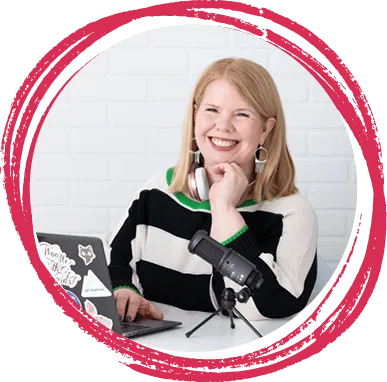
I’m Maggie Patterson (she/her), and services businesses are my business.
I have 20+ years of experience with client services, am a consultant for agency owners, creatives, and consultants, and vocal advocate for humane business practices rooted in empathy, respect, and trust.
Read or Listen to the Latest
For Solo Business Owners
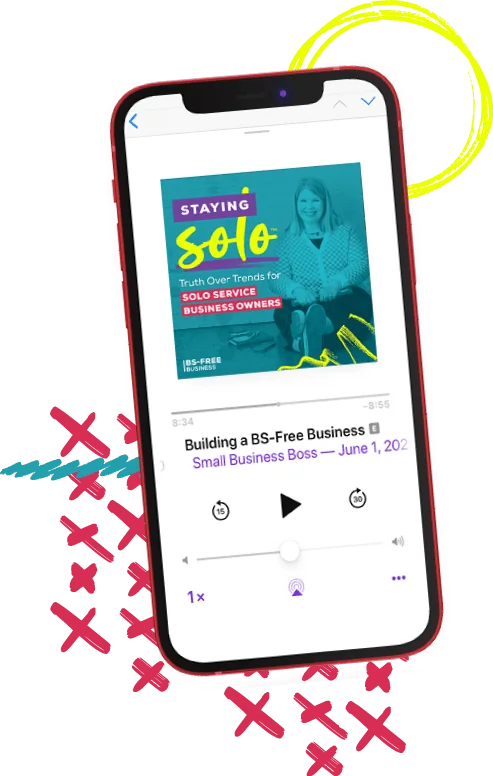
Growing a solo service business is tough.
It’s even harder when you’re bombarded with BS advice that steers you away from your values and why you started your business in the first place.
This is the podcast for solo creatives and consultants who want to remain as a team of one and have zero interest in the hustle and grind of typical business teachings.
Subscribe now and never miss an episode.
For Micro Agency Owners
Most podcasts for agency owners obsess over revenue growth as the ultimate success metric.
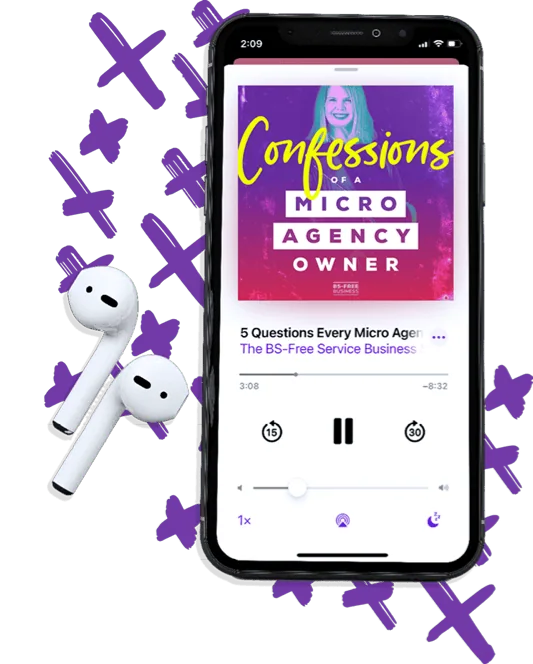
But here’s the truth: not everyone wants to make millions. Your goal might be to build a sustainable business that lets you have a life and doesn’t run you into the ground.
Join me as I spill my shameless confessions and share everything I’ve learned about building a micro agency that skips the BS of tired and typical agency teachings.
Follow Now on All Major Podcast Platforms
